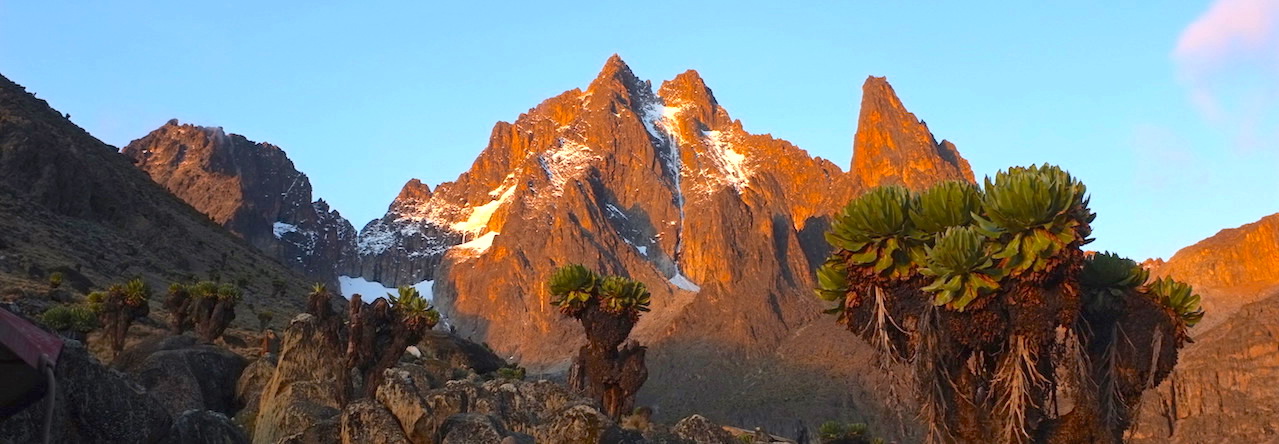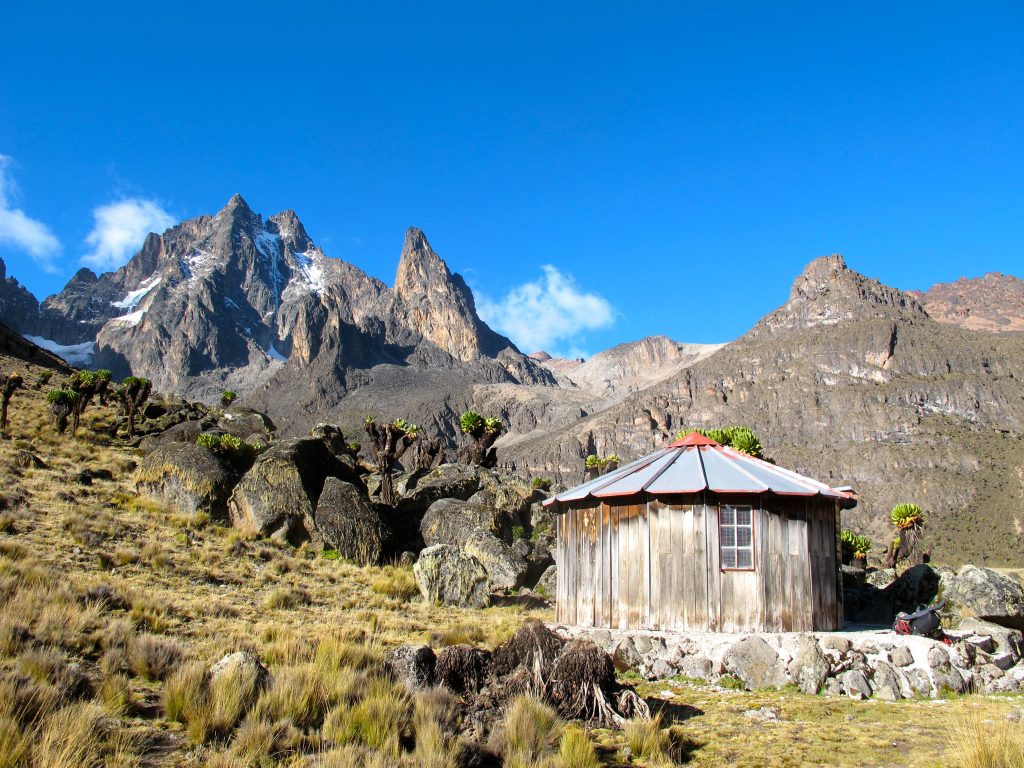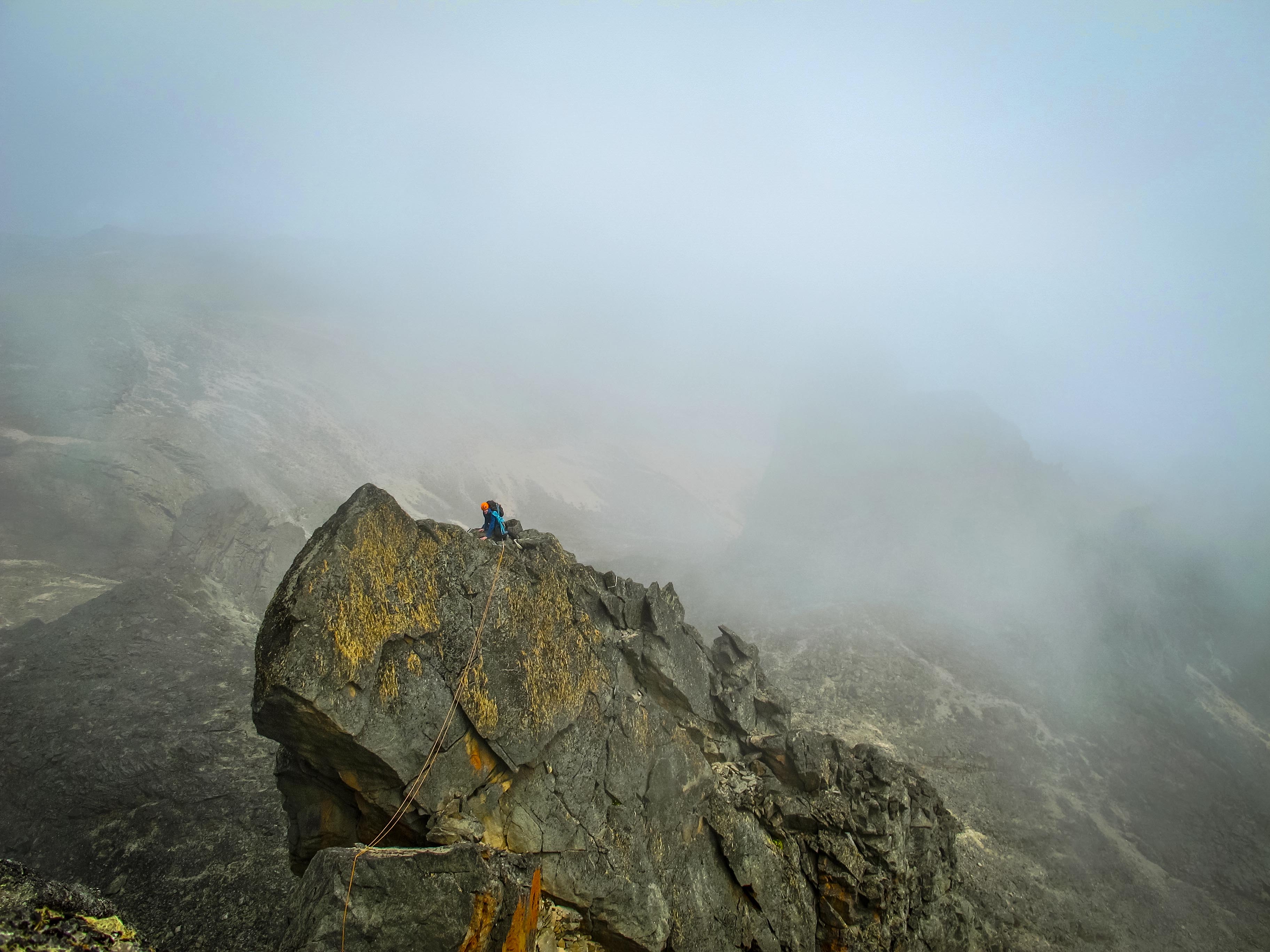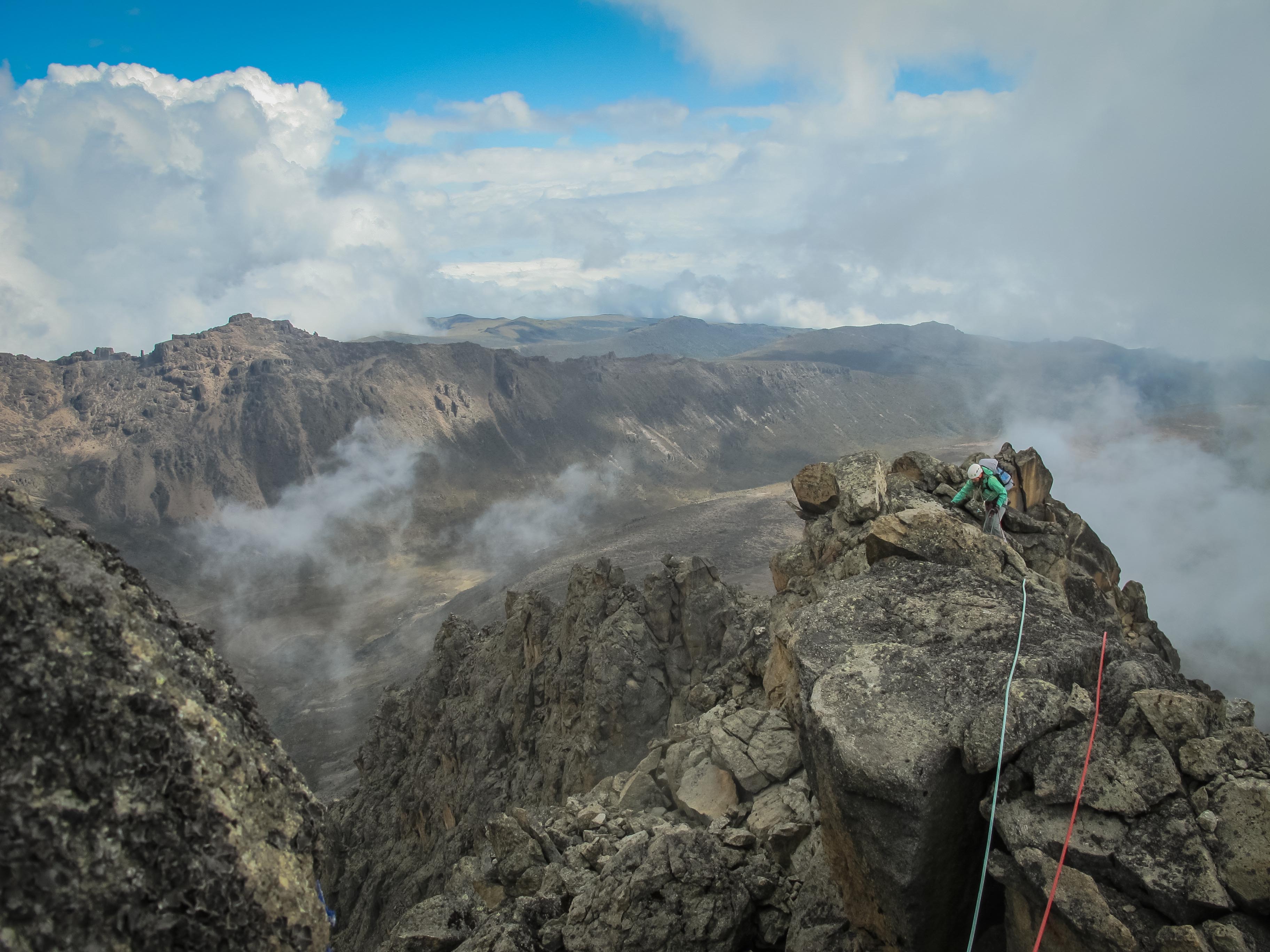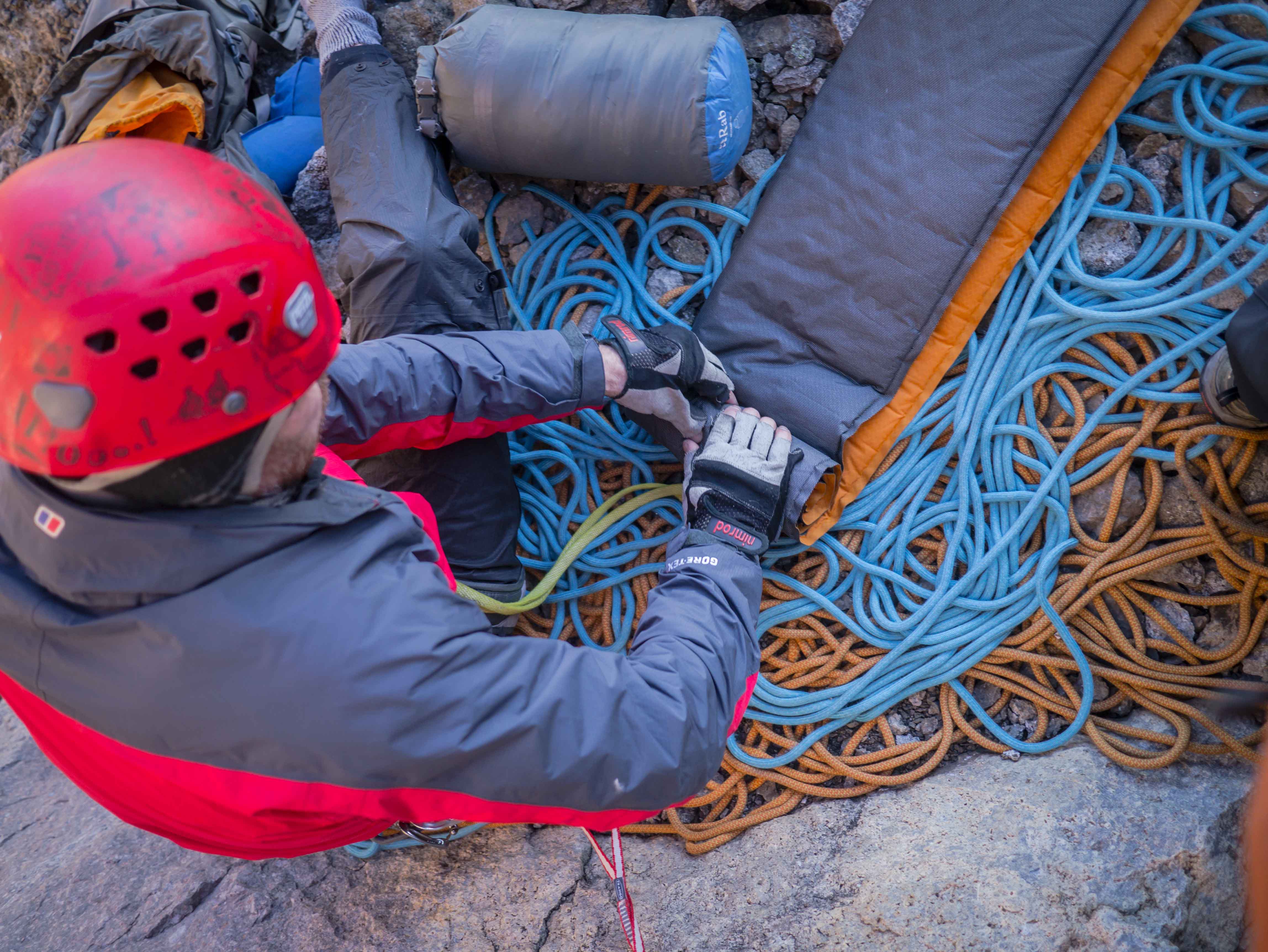INTRODUCTION
In 1997 UNESCO inscribed Mount Kenya a World Heritage Site as “one of the most impressive landscapes in Eastern Africa with its rugged glacier-clad summits, Afro-alpine moorlands and diverse forests that illustrate outstanding ecological processes”. Since 1978, the area is also an International Biosphere Reserve. Mt. Kenya, an extinct volcano that last erupted between 2.8 to 3.2 million years ago, was gazetted a National Park in 1949 and a National Reserve in 2000 and is managed by Kenya Wildlife Service (KWS).
In the 2800 sq km National Park and National Reserve are over 800 recorded plant species with 81 species being endemic to Mt. Kenya; There is also a wide variety of wildlife such as elephant, buffalo, eland, bushbuck, waterbuck, zebra, hyena, colobus monkey, white-throated guegnon and common at higher altitudes, the ubiquitous Mt Kenya rock hyrax. Animals rarely seen include leopard, bongo, giant forest hog and rhino.
The elevation range is approximately 2200 metres to 5200 metres and includes several distinct vegetation zones: Mixed broad-leaf forest, Gallery Forest, Bamboo, Giant Heath and Hagenia, moorland tussock grasses, Giant Senecio and Lobelia-and, at the uppermost elevation, rock and ice.
The peak area is formed from the hard core or plug of the volcano, the crater having long since been eroded away, and rises steeply on all sides some 450 m above the glaciers and scree slopes. There is excellent rock and ice climbing of a high standard to the twin summit peaks of Batian (5199 m) and Nelion (5188 m). The third highest peak is Pt. Lenana (4985 m) which can be reached by any fit walker, suitably equipped.
Despite its size, it is possible to gain altitude rapidly on Mt. Kenya and overzealous climbers run the risk of high altitude sickness. Mt. Kenya is responsible for a large proportion of the world’s high altitude pulmonary oedema cases (a potentially fatal form of High Altitude sickness). This can be prevented (and the experience made more enjoyable) if a sensibly slow approach is made.
Also, because Mount Kenya is so close to the equator, night can descend with surprising rapidity, only about half an hour after the sun has set, which can catch out visitors from further latitudes.
Mount Kenya, like most mountains, can be a very dangerous place. Many people are injured and even killed each year. Do not attempt the mountain if you suffer from any health problems, or if you do not have the appropriate gear.
With recent warming and recession of the glaciers on Mt. Kenya, the Lewis Glacier now often has a hard snow or ice cover, making walking over it hazardous without the proper equipment (crampons, ice axe). Climbers particularly should take special note of changes to climbing routes due to the shrinking glacier cover.
KWS regulations require all visitors to register upon entrance to the mountain and sign out on departure. Hiking alone is prohibited. No burning is allowed. Take all litter out with you.
ACCESS
To the Park – Mt. Kenya lies some 200 km north of Nairobi. Good roads lead to the nearby towns of Naro Moru (west side), Chogoria (east side) and Nanyuki (north side). From these locations, roads and tracks (approx. 20-30 km in length) lead up to the three main roadheads and the park gates. Some of these are often in very poor condition, necessitating a 4-wheel drive vehicle, or walking. The roads to Met Station from the Naro Moru Gate and to Old Moses from the Sirimon Gate are passable without a 4wd vehicle.
Car hire in Nairobi is readily available or one can take public buses (matatus) from Nairobi for around Ksh 700 – although those are not the safest form of transport they can get you to the turnoff from the main road. Then, to get to the roadheads one has to walk or get one of the motorbike taxis that are usually found near the Sirimon turnoff from the main road, or at Naro Moru.
Entry to and exit from the Mt. Kenya National Park can only be made during daylight hours before 6pm. The forest zone can be dangerous due to buffalo and elephant, especially at night. Although the higher huts on the mountain (above 4,000m) can be reached in one day from the road, its strongly recommended that two days be taken unless you are already acclimatised.
PARK FEES ON MT. KENYA
Mt Kenya is located within the Mt Kenya National Park and managed by the Kenya Wildlife Service (KWS) – entry fees and other info are available here
GUIDES AND PORTERS
Beware of rogue guides and porters. All guides and porters must have valid KWS issued cards. These are bona fide licenced groups offering guiding and porter services. This is a benefit to the visitor since guides and porters are granted entry to the park at half price with such a card. Also any problems with the guides/porters can be followed up since they are known and registered groups. Visitors should obtain receipts for payments made for the park/reserve, which must be shown when leaving.
ENVIRONMENT
Do not burn any vegetation, particularly dead Lobelias and Groundsells at the higher altitudes, which form an important part of the mountain’s fragile ecosystem. There have been several huge fires in recent years over both higher and lower slopes. Carry out all your litter.
THREE MAIN ACCESS ROUTES
The Naro Moru, Chogoria and Sirimon Routes are by far the most popular routes up the mountain. Other routes (Timau, Burguret, Kamweti and Meru) have existed in the past, but have now fallen into differing states of disrepair and considerable navigation skill and physical strength and stamina are now required to attempt them, as well as a permit from the Park Headquarters. There are some tour operators offering guiding on these routes.
Timings given should be adequate for moderately fit parties not too heavily laden, with allowance only for brief halts. A good reserve should always be allowed for, and a start should be made early in the morning. For the descent allow at least half the time taken on the ascent.
A tent is useful if weight allows. Otherwise, the mountain has several huts. Most of the huts are privately owned. If you plan to stay in huts, please contact the appropriate organisations for bookings. Fees help maintain the huts.
It is recommended to spend at least one night at the roadhead to help acclimatise.
NARO MORU
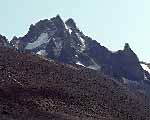
This route to the Teleki Valley is the shortest way to the peaks and is one of the most popular tracks. Owing to the fact that it is the shortest way up the mountain, there is a tendency for visitors to ascend too quickly and become
the victims of mountain sickness and other illnesses related to altitude. It is therefore strongly advised that visitors unaccustomed to high altitude should consider hiking the first day from the Park Gate to the Met Station, rather than driving this stage of the ascent.
From Naro Moru town a well signposted mostly paved road leads 17 km to the Park entrance (2,400 m). If driving from Nairobi one can also follow the signposts for Naro Moru gate around 10 km before Naro Moru town, following a good paved road which then joins up with the road from Naro Moru town itself. After the Park entrance a paved road leads to the Met Station trailhead at 3,050 m where cars can be parked. A concrete walking track then climbs more steeply passing the MET station and then narrows to a footpath leading to the edge of the forest.
A steep, marshy section known as the “vertical bog” follows. The route keeps to the south side of the ridge, through open moorland until (about 3½ to 4 hours from the Met Station) the path reaches the crest of the ridge overlooking the Teleki Valley (4,000 m). The path contours along the south side of the Teleki Valley, keeping first high, and then gradually descends to reach the valley floor. It then follows the valley to reach Mackinder’s Camp (4,200 m) with spectacular views of the south side of the mountain. From the Met Station to this point is about five to six hours.
The Austrian Hut (4,790 m) can be reached in a further three or four hours, but it is advisable not to attempt this from the Met Station in one day. The path to Austrian Hut (and onwards to Pt Lenana) leads from Mackinder’s Camp and initially contours up the left-hand side of Teleki Valley. A long pull then leads up the lateral moraine of the Lewis Glacier, veering left to the rocky bluff where the Austrian Hut is situated. Austrian Hut was the common starting point for those attempting the South-East Face of Nelion but it is also possible to access the route from Mackinder’s camp in about 3 hours
The KWS Rescue Ranger Station is located near the head of the Teleki Valley and close to the Mountain Club of Kenya hut.
CHOGORIA ROUTE
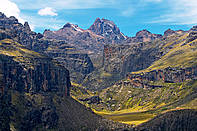
The Chogoria route is considered the most picturesque on the mountain. It has no huts and requires climbers and hikers to be self-sufficient for camping.
The route begins from Chogoria town to the east of the mountain, about 96 km from Embu and 64 km from Meru. From here a 4 wheel drive vehicle is necessary to drive the 29 km track to the Park Gate at 3,000 m. There is accommodation available here at the Meru Mt Kenya Bandas. From the gate, the track continues to the Chogoria roadhead. From here the path tracks the north side of the Gorges Valley to reach Hall Tarns (4,230m) sitting on a plateau above Lake Michaelson. To reach Hall Tarns takes between 6 and 9 hours from the Chogoria Gate.
The path from Hall Tarns eventually splits. The right-hand path continues to Simba Col (4,620m) from where you can descend to Shipton’s Camp and the Mackinder Valley or continue up the ridge to Harris Tarn and then to Pt Lenana. The left-hand path takes you steeply up to Tooth Col and round Pt Lenana to the south to reach Austrian Hut.
SIRIMON ROUTE
This track provides the easiest access to the northern side of the central peaks and the North Face Standard Route on Batian. It is a beautiful route with fine views of Sendeo and Terere, and of the main peaks. About 15 km from Nanyuki on the Timau road, just before the road winds down to cross the Sirimon River, a signposted track to the right leads 10 km to the Park Gate.
A paved road from the gate leads to Old Moses Hut and Judmaier Camp at the roadhead at 3,350 m. The track climbs 300m up the hill behind the hut to a communications station. Just beyond this point the track splits with the left hand route proceeding to the Mackinder Valley direct, and the right hand route going via the Liki North Hut.
The direct route contours the moorland across a series of ridges, dropping down to cross the Liki North River (where there is a bridge and picnic site) and then climbing the ridge to enter the Mackinder Valley. The path continues up the valley to the cliffs beneath Shipton’s Cave. From here the path climbs steeply up to the right and continues to Shipton’s Camp hut (4,250 m). From Old Moses to this point is about 6-7 hours.
The route via Liki North hut is tougher (8-9 hours to Shipton’s Camp). From the split head uphill towards a rounded hill called the Barrow. The path swings south climbing to the ridge of the Liki North Valley and then drops to the Liki North Hut (3,990m). The hut no longer exists but there is a campsite and this is a popular starting point for climbs on Sendeo and Terere. From the Likii North Hut the path climbs the ridge and then descends into the Mackinder Valley to join the direct route.
From Shipton’s Camp two main paths continue. To the right of the main peaks the path climbs to the Hausberg Col via Kami Tarn (which lies close to the start of the North Face Standard route. To the left the path ascends to Harris Tarn from which Pt Lenana can be reached.

HUTS
There are a number of accommodation options outside the Mt Kenya National Park in the nearby towns of Nanyuki, Naro Moru and Chogoria. It is possible to camp or stay in bandas at the park gates. Please enquire directly with the operators of the accomodation for the latest fees. The fees below were accurate as of February 2019.
Accommodation on the mountain depends on the route hiked and there is a mixture of huts and campsites along each route. A tent is useful (or essential on the Chogoria Route or less well-travelled routes). Otherwise, the mountain has several huts, though it should be noted that several huts listed in old guidebooks have been demolished. Most of the existing huts are privately owned. If you plan to stay in huts, please contact the appropriate organisations for bookings. The fees help maintain the huts.
PARTIES USING THESE HUTS SHOULD LEAVE THEM CLEAN AND TIDY, AND BRING ALL GARBAGE OFF THE MOUNTAIN. PLEASE DO NOT MAKE USE OF OLD RUBBISH DUMPS.
NARO MORU ROUTE · Naro Moru River Lodge, 1.5 km from the main road in Naro Moru town, is a popular starting point with bunkhouse and guesthouse accommodation. · Met Station (3,050m) has basic self-service accommodation and camping at the roadhead of the Naro Moru route as is accessible on a paved road. The fees per person per night at Met Station for Kenyan citizens and residents are 1500 Ksh in low season (1 March-30 June and 16 September-8 December) Ksh , and 1900 Ksh in high season (all other times). For non-residents the rates are 26 USD for high season and 21 USD for low season. · Mackinder’s Camp (4,200m) in the Teleki Valley has a hut accommodating 66 people. The fees per person per night for Kenyan citizens and residents are 2000 Ksh for low season and 2600 Ksh for high season (same dates as above). The rates for non-residents are 27 USD for low season and 36 USD for high season.
Both Met Station and Mackinder’s Camp are owned by Naro Moru River Lodge. Fees are payable at a booking agent, the park/reserve gates, or online. Mountain Club of Kenya (MCK) members pay discounted rates when booked direct with the lodge.
· Austrian Hut (4,790 m) has three rooms and sleeps 30 people. It was opened in February 1973. Austrian Hut is manned by Kenya Wildlife Service staff, and costs 2000 KSh per night (same price for residents and non-residents). Payment can ONLY be made at the park/reserve gates for which a receipt MUST be obtained. Unplanned or additional nights at Austrian Hut are possible but payment for this is made at the park gate on exit against a receipt and NOT direct to the staff manning the hut.
SIRIMON ROUTE · Old Moses Hut (3,350 m) at the Sirimon Route roadhead offers self-service accommodation and costs 2500 Ksh per person per night (same price for residents and non-residents). · Shipton’s Camp (4,250 m) in the Mackinder Valley sleeps 40 people. It costs 3000 Ksh per person per night (same price for residents and non-residents).
Both huts are owned by Mountain Rock. MCK members pay discounted rates when booked direct at the lodge. Both of these can be reserved in Nairobi, at the Mountain Rock Hotel in Nanyuki, or online
· Liki North (3,993 m) no longer has a hut but there is a campsite.
CHOGORIA ROUTE The Chogoria Route is only for parties equipped for camping. Tents must be shown at the Chogoria Park Gate before parties can enter. · Meru Mt. Kenya Lodge at the Chogoria Gate costs US $15 per person. · Minto’s Hut (4,297 m) is by Hall Tarns. The hut is for use by porters only.
ON NELION Howell Hut (5,188 m) – This magnificent bivouac shelter is located on the summit of Nelion. It was built by Ian Howell in February 1970 after five loads of construction materials had been successfully parachuted onto the Lewis Glacier. In a feat which can only be described as remarkable, Howell then made thirteen solo ascents of Nelion as he gradually carried the materials to the summit. The floor is foam covered. Baillie’s Bivy is about half-way to the top of Nelion but it has fallen into disrepair, often filled with snow and ice. Few people stay there nowadays.
WALKING
Most enjoyable during the dry seasons, particularly in January, February, early March and August when the best views are expected. Besides the ascent of Lenana, the circumnavigation of the main peaks is recommended. For the adventurous, carrying a tent is worth the extra weight as reliance on huts can be restricting. Route finding can be difficult in cloudy weather and unguided parties must be suitably equipped, and familiar, with map and compass.
The easiest route up Point Lenana is from Austrian Hut and usually goes onto the Lewis Glacier. Always take proper precautions when on any glacier. Point Lenana can require at least an ice axe at some times of the year. There is a route up to the summit of Point Lenana from the north, but it is steep and loose and should only be attempted by the experienced.
Stay on trails whenever possible. This protects the surrounding vegetation and prevents soil erosion. If you are hiking where no trails exist, spread the impact so that you don’t create new trails. The environment in mountain areas can be extremely fragile. When taking breaks, choose areas that will not show much human impact, such as rock or bare ground. Sitting on vegetation leads to its destruction.
IF YOU GET LOST
“It can’t happen to me.” or “I don’t need a survival kit.”
Particularly in the featureless moorland zones, it can be easy to get lost. Nearly fifty people have become lost on Mt. Kenya since 1990. People tend not to think about or anticipate emergencies. Start now. If your gear is being carried by porters (who hike separately from clients) or you are on a day hike or a summit bid, then you must have a day-pack containing at least the following essentials: instant body shelter (warm and water proof), fire making capability, signaling capability (small mirror), food and drinks, First Aid package, map, compass and torch.
It is important to be aware of your intended route. The most common cause of getting lost is when swift moving clouds envelop and area and hikers lose the trail – often walking further away in an effort to regain the trail. Stay where you are if visibility is poor. If you become lost do not panic, take shelter under a tree, senecio or rock overhang and stay where you are. Help will come, but it is typical to be out overnight. In sunlight, use a mirror to signal and lay out a brightly coloured article to alert the searching aircraft or hiking rescue party. Consider safely lighting a fire with dry grass, twigs, roots and branches and once burning well, generate smoke by adding small amounts of green vegetation without suffocating the ‘source-fire’. Be careful not to set the environment on fire and endanger yourself. Being on a ridge top will make you more visible. Do not descend into a valley or forest as this will make you difficult to find and could take you several days of hard going to emerge into human settlement. There can be a fee for any rescue the park carries out.
CAMPING
When you camp, try to pitch your camp in already existing camp sites, rather than choosing virgin spots. If no existing camp site is available, try to pitch your camp away from trails and water sources. In areas of heavy use, choose campsites that show obvious use. This concentrates the impact in one area and prevents widespread destruction of the environment.
In areas where previous use is not obvious, camp on durable surfaces such as rock or bare ground, instead of vegetation. Camping at least 50 metres away from water helps prevent contamination of the water by human waste. In all cases, try to leave the camping area in better condition than you found it.
You must bring a camping stove for your cooking. Camp fires are not permitted above the forest edge in Mt. Kenya National Park & National Reserve. While there may appear to be wood available for fires, the small amount present is an important source of nutrients for the soil and future plant growth. Therefore, a camp stove should be included in your equipment.
CLIMBING
The easiest routes to the highest peaks, Batian and Nelion, are IV (UIAA grading). Few parties reach Batian summit and descend before nightfall. There are more than 25 routes to the main summits of which 8 are ice routes concentrated on the south and west sides. There is little scope for new routes. 90% of visiting climbers underestimate Mt. Kenya and it is unlikely that more than one route to the summits will be made in any one visit to the mountain. There are good shorter climbs on outlying smaller peaks.
Climbers particularly should take special note of changes to climbing routes due to the shrinking glacier cover. Some climbs have seriously changed.
SEASONS
Although Mt. Kenya is situated on the equator it has very definite summer and winter conditions on its north and south faces. The two rainy seasons (around mid March to June and October to December) can make the approach difficult and the rock routes wet or verglassed. Attention should therefore be paid to choosing the correct time to climb the mountain. Rock routes on the south side are usually in condition from end of December to mid March and on the north side from late June to mid-October. Ice routes are normally in condition during the same periods given above but on the opposite face of the mountain. East facing rock routes tend to be free of ice during both dry periods.
Climbers particularly should take special note of changes to climbing routes due to the shrinking glacier cover. Some climbs have seriously changed.
WILDLIFE
 Wild animals on Mt. Kenya do not normally come in contact with hikers and because of the dense forest most species are rarely seen. If surprised or provoked they, particularly cape buffalo and elephant, may attack. Talking, frequently clapping or making a ‘hooting’ sound while hiking through the forest zones warns animals you are approaching and they should move away from you. Do not approach the animal or proceed along the trail if it fails to move away. Consider backtracking away from elephant and buffalo in particular. Feeding wild animals disrupts their natural behaviour and this includes monkeys, hyrax and birds. You may also be attacked if the animal is aggressive, so exercise caution and leave the wildlife alone. Do not break twigs or branches and leave flowers to grow where you find them — that is where they are most beautiful.
Wild animals on Mt. Kenya do not normally come in contact with hikers and because of the dense forest most species are rarely seen. If surprised or provoked they, particularly cape buffalo and elephant, may attack. Talking, frequently clapping or making a ‘hooting’ sound while hiking through the forest zones warns animals you are approaching and they should move away from you. Do not approach the animal or proceed along the trail if it fails to move away. Consider backtracking away from elephant and buffalo in particular. Feeding wild animals disrupts their natural behaviour and this includes monkeys, hyrax and birds. You may also be attacked if the animal is aggressive, so exercise caution and leave the wildlife alone. Do not break twigs or branches and leave flowers to grow where you find them — that is where they are most beautiful.
WASTE DISPOSAL
Refuse left by careless hikers is not only an eyesore but can also be harmful to all forms of wildlife.
There is no proper means of waste disposal on the mountain other than packing litter out. Buried litter breaks down extremely slowly in this environment and is liable to be dug up by animals. Unsightly and unhealthy garbage pits result. Burning is illegal.
You will be asked to produce your litter at the gate on your return.
If you have extra supplies, give them directly to someone who will use them. Do not leave them out with the litter. Do not feed the animals as this disrupts their normal existence, increases impact on vegetation surrounding the huts / campsites and could result in the destruction of the animal itself.
Be a part of the Mt. Kenya cleanup effort. Bring back more than just your own litter. This will help make the mountain cleaner.
SANITATION
With so many individuals concentrated in limited areas on the mountain it is vital to protect water sources from contamination. Plan on purifying all drinking water, either by boiling, filtration, or use of purification tablets. Never use soap directly in water sources. Even the best biodegradable soaps take several days under ideal conditions to break down. Where possible move at least 10 metres away from the water sources before using soap.
Human faecal material is a major source of water contamination on the mountain. Where they exist, use an established toilet (choo). Ultraviolet radiation from the sun and organisms present in the soil are the best decomposers of human waste. At high altitudes those soil organisms are not very abundant. Therefore, sunlight provides the best form of decomposition. Select a site well away from campsites, trails and at least 30 metres away from water, with lots of sunlight exposure. Leave faeces on the surface of the ground. Scattering and smearing the faeces around will maximise exposure to sunlight. At lower elevations such as below 3500 metres where soils are rich in decomposing organisms, burying faeces in shallow holes is the most effective method. Toilet paper and sanitary towels should be packed out with other litter.
MOUNTAIN HEALTH
The combination of strong equatorial sun and thinner air makes sunburn and snowblindness very common. Protect your skin and eyes from the sun. Dehydration predisposes hypothermia and altitude illness. Drink 4 to 6 litres of fluids per day. A diet high in carbohydrates supplemented by other foods will best prepare your body for the challenging alpine environment.
Headache and slight nausea are common effects of altitude for the first night above 4,000 m (13,000 ft).
Dress right, eat right, drink right – These guidelines may save your life. Extremes of heat, cold, wind and sun can adversely affect visitors to Mt. Kenya. Temperatures range from 30°C (90°F) to 15°C (0°F). Hypothermia or exposure is a life threatening lowering of the body core temperature. It can occur in air temperatures as high as 10°C (50°F). UV protection and dark glasses should be carried.
HYPOTHERMIA or EXPOSURE
Signs/symptoms are clumsiness, stumbling apathy, lethargy, loss of enthusiasm and thinking ability, disorientation and unconsciousness.
Treatment requires early recognition and aggressive steps to warm the hypothermic person. Find shelter. Remove wet clothing. Create a warm and dry environment for the victim. Put the victim in a sleeping bag with one or two other people stripped to their underclothes. If the casualty is able, drinking warm, high caloric fluids like cocoa will help. The recovering hypothermic person will need rest and should be taken off the mountain. (see below)
The combination of strong equatorial sun and thin air makes sunburn and snowblindness very common. Protect your skin and eyes from the sun. Dehydration predisposes hypothermia and altitude illness. Drink 4 to 6 litres of fluid per day. A diet high in carbohydrates supplemented by other foods will best prepare your body for the challenging alpine environment
ALTITUDE SICKNESS
Above 3,000 m, very few visitors avoid altitude sickness completely. Visits are much more enjoyable if you allow two nights either at the road heads at 3,000 m, or at the higher huts at around 4,000 m. before proceeding higher. On the first day, hiking from the park gates to the road-heads is strongly recommended. Increase fluid intake to 4 to 6 litres per day, avoid extreme physical exertion and eat a light diet high in carbohydrates. Take the symptoms seriously. Rest and acclimatise if AMS is suspected. Immediately report to the rescue ranger station and descend if High Altitude Pulmonary Edema or High Altitude Cerebral Edema is suspected.
At high altitudes, the available amount of oxygen decreases dramatically. This can result in medical situations that must be of concern to every visitor. These range from Acute Mountain Sickness, with various degrees of discomfort, to High Altitude Pulmonary Edema and Cerebral Edema, both of which can be fatal. Because cases can progress rapidly fram mild to severe, recognition of symptoms is essential.
Acute Mountain Sickness (AMS)
Signs/symptoms: Headache, nausea, fatigue, malaise, loss of appetite and difficulty sleeping.
Treatment: Slow down, stay in camp, drink plenty of fluids and rest while the body adjusts to the altitude. If symptoms persist after 48 hours, descend.
High Altitude Pulmonary Edema (HAPE)
Signs/symptoms: Shortness of breath during exercise progressing to shortness of breath at rest, a dry cough deteriorating to a frothy sputum, audible gurgling (rales) from the chest area, increased heart and breathing rate.
Treatment: Immediately descend and seek medical attention. Descent is the only treatment as High Altitude Pulmonary Edema does not improve with rest at altitude. Symptoms can progress quickly to a point where the victim cannot walk.
High Altitude Cerebral Edema (HACE)
Signs/symptoms: Symptoms of Acute Mountain Sickness that progress to severe headache, loss of co-ordination, slurred speech, irrational behaviour, then coma.
Treatment: Same as High Altitude Pulmonary Edema: descend.
Some climbers find that certain drugs can help prevent or reduce AMS symptoms, but these drugs should never be used to treat AMS/HAPE/HACE. Consult your doctor before going to the mountain.
EMERGENCY PROCEDURES
In case of an emergency (a severe injury or illness where outside help is needed) contact a KWS official immediately. The Ranger Station the head of the Teleki Valley and Austrian Hut are permanently manned as is the Met Station and the Naro Moru, Sirimon and Chogoria Gates. All have radios. You may also be assisted at Mackinder’s Hut in the Teleki Valley and Shiptons Hut in the Mackinders Valley. Write down all the information on the victim’s condition and location. Mark the victim’s position on the map. Be familiar with the nearest source of help while on the mountain.
EQUIPMENT & CLOTHES
Little camping or climbing equipment if any can be bought in Nairobi. Some equipment can be hired from Naro Moru River Lodge and East Africa Mountain Guides, but should not be relied upon. Generally, alpine equipment is adequate with an emphasis on a good sleeping bag. The nights are long and sometimes down to -5°C. There is often heavy rain and snow but violent storms are rare.
Be sure you have appropriate gear for the duration of your trip. In the wet climate of Mount Kenya, garments of wool and synthetic insulated materials are preferable to cotton or down. When you are hiking with a guide or porters or companions, be sure to keep adequate gear in your rucksack so that you have what you need should you become separated — a map, compass, food, water, first aid kit, warm and waterproof clothing, a signalling mirror,matches/lighter and a flashlight are essential.
FOOD
Supermarkets in Nairobi can supply most food requirements, although specialised lightweight and freeze dried foods are generally not obtainable. For cooking C206 Gaz cylinders and dry cleaning fluid are available and recommended instead of Kerosene which is often dirty. Appetites change with altitudes and the desire for heavy meals dwindles. Plenty of “brewing” ingredients are advised, including tea, chocolate and citrus fruit drinks.
Do not feed any of the animals or birds, especially the Hyraxes.
GUIDES AND PUBLICATIONS
The comprehensive Guide to Mt. Kenya and Kilimanjaro edited by Iain Allan is available whilst principal walking routes are covered in The Mountains of Kenya, a walker’s guide, by Paul Clarke. These can be obtained from the MCK or bookshops in Nairobi and even through selected distributors in the UK and USA.The existing “Guide to Mount Kenya and Kilimanjaro” is still the most up-to-date guide of all climbing routes on those two mountains, although few new routes have been done on Mount Kenya since the latest edition (1998).
A selected climbing guide by Andrew Wielochowski is available from West Col Productions, Goring, Reading, Berks RG89AA, England. A 1:125,000 scale tourist map of Mt. Kenya National Park and Reserve and Environs, published by Survey of Kenya, is sometimes available in Nairobi. More useful is the 1:50,000 scale Map and Guide of Mt. Kenya by Wielochowski and Savage, available from West Col, MCK and Nairobi Bookshops (in the same series, maps of Kilimanjaro, Mount Elgon and Rwenzoris are also available).
